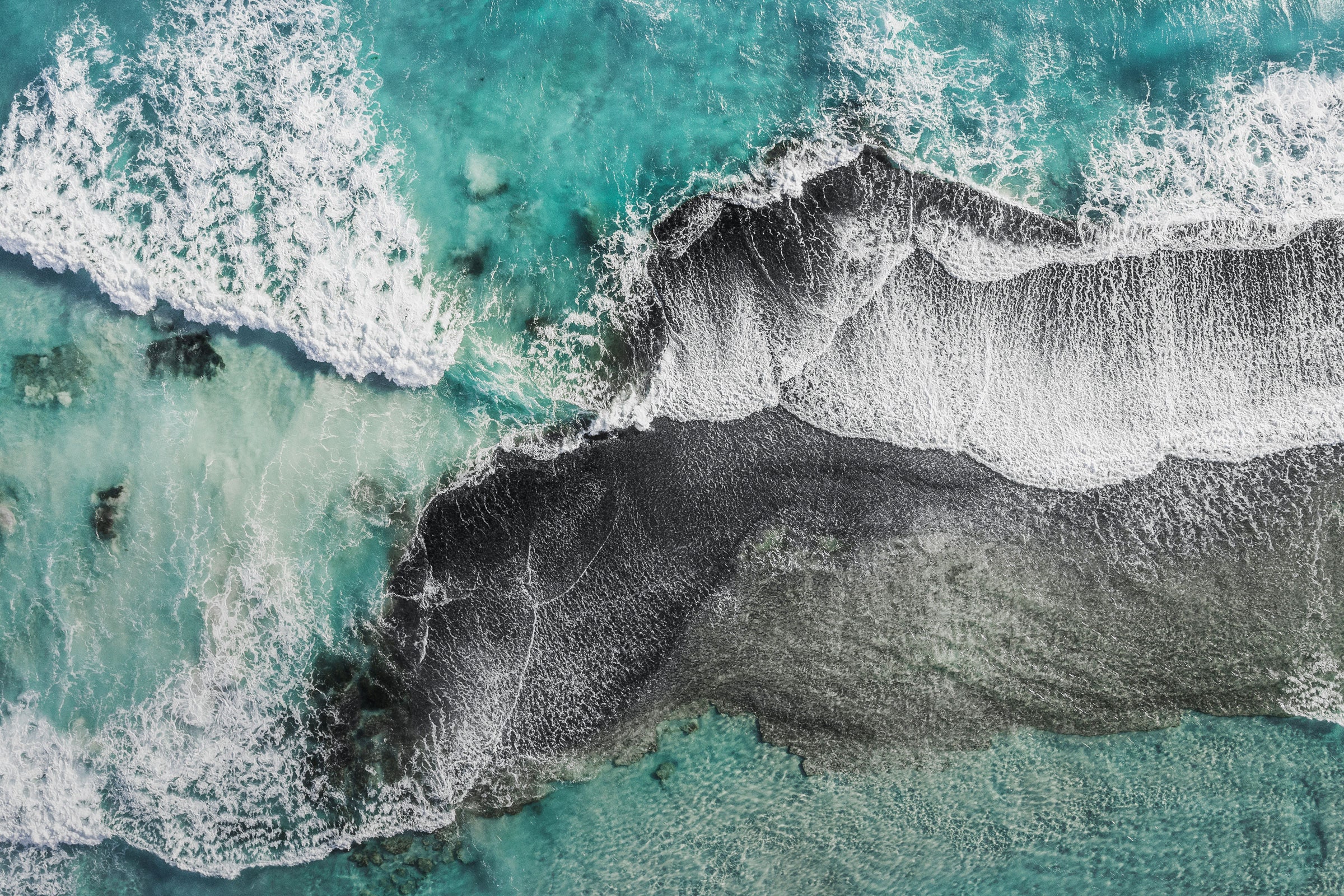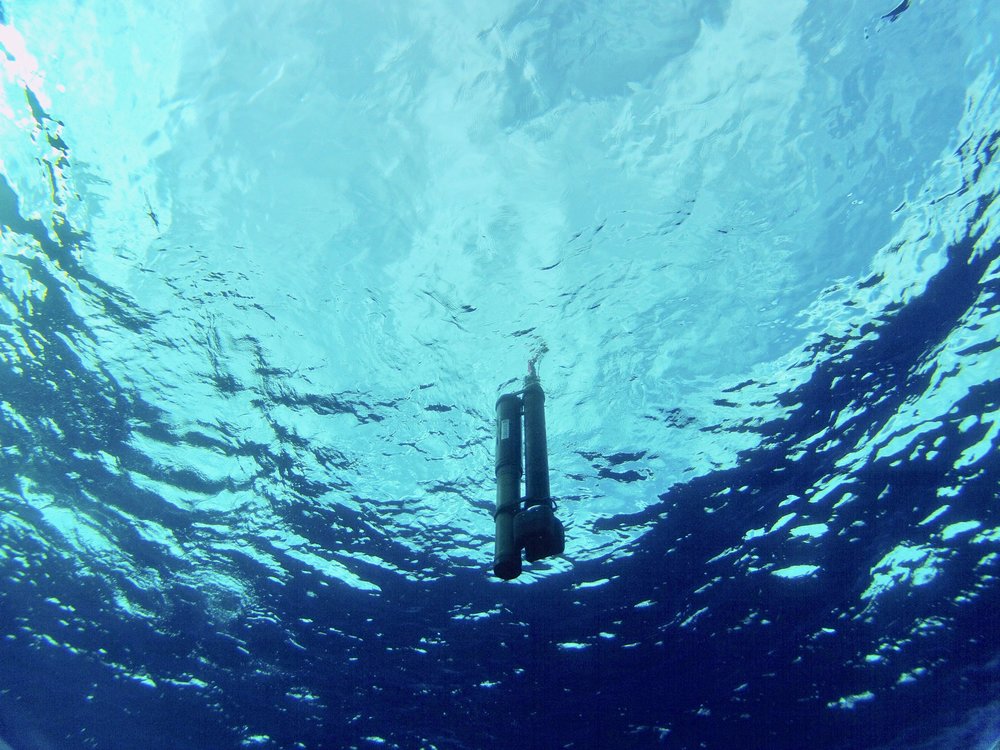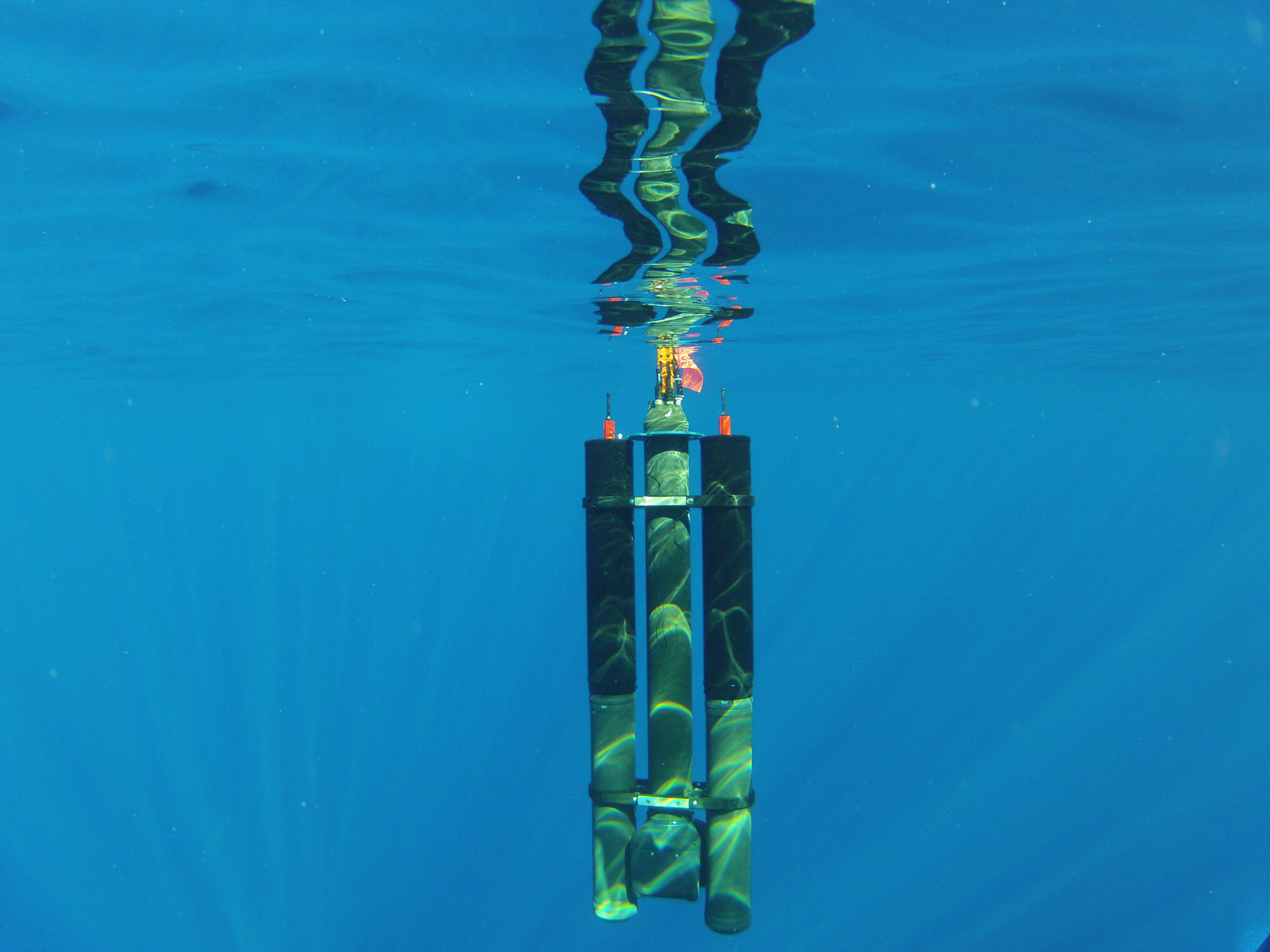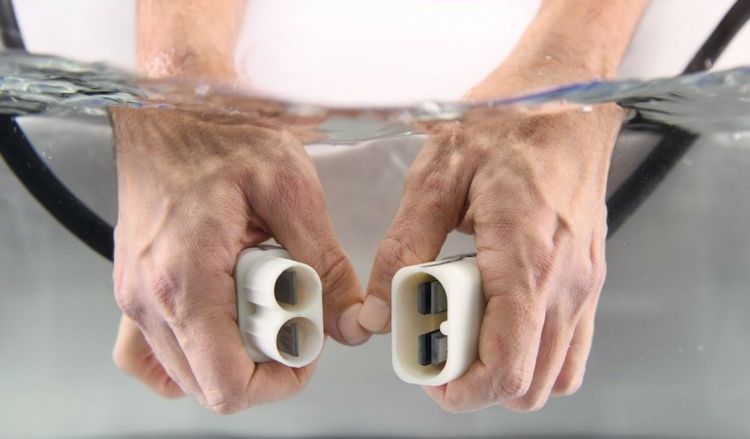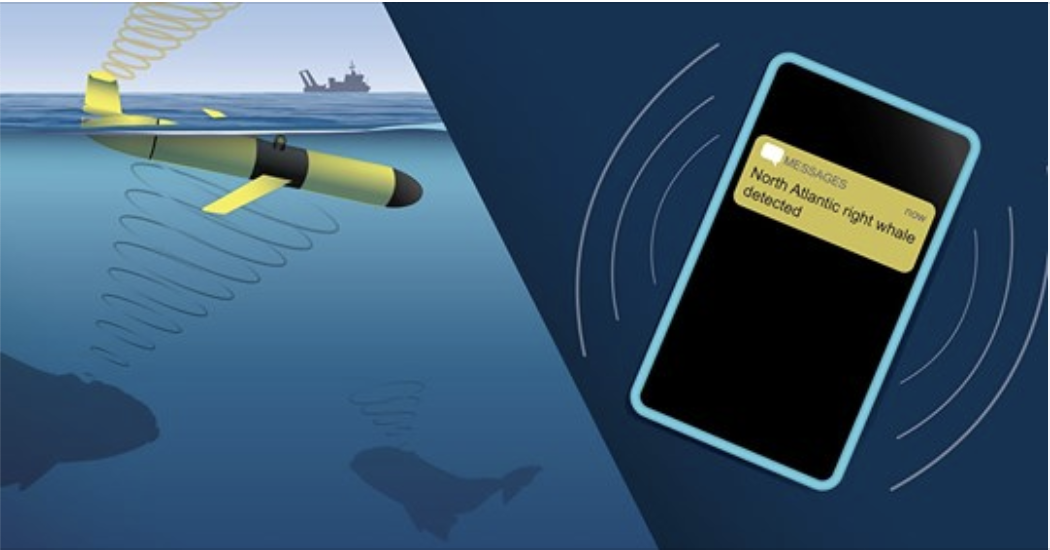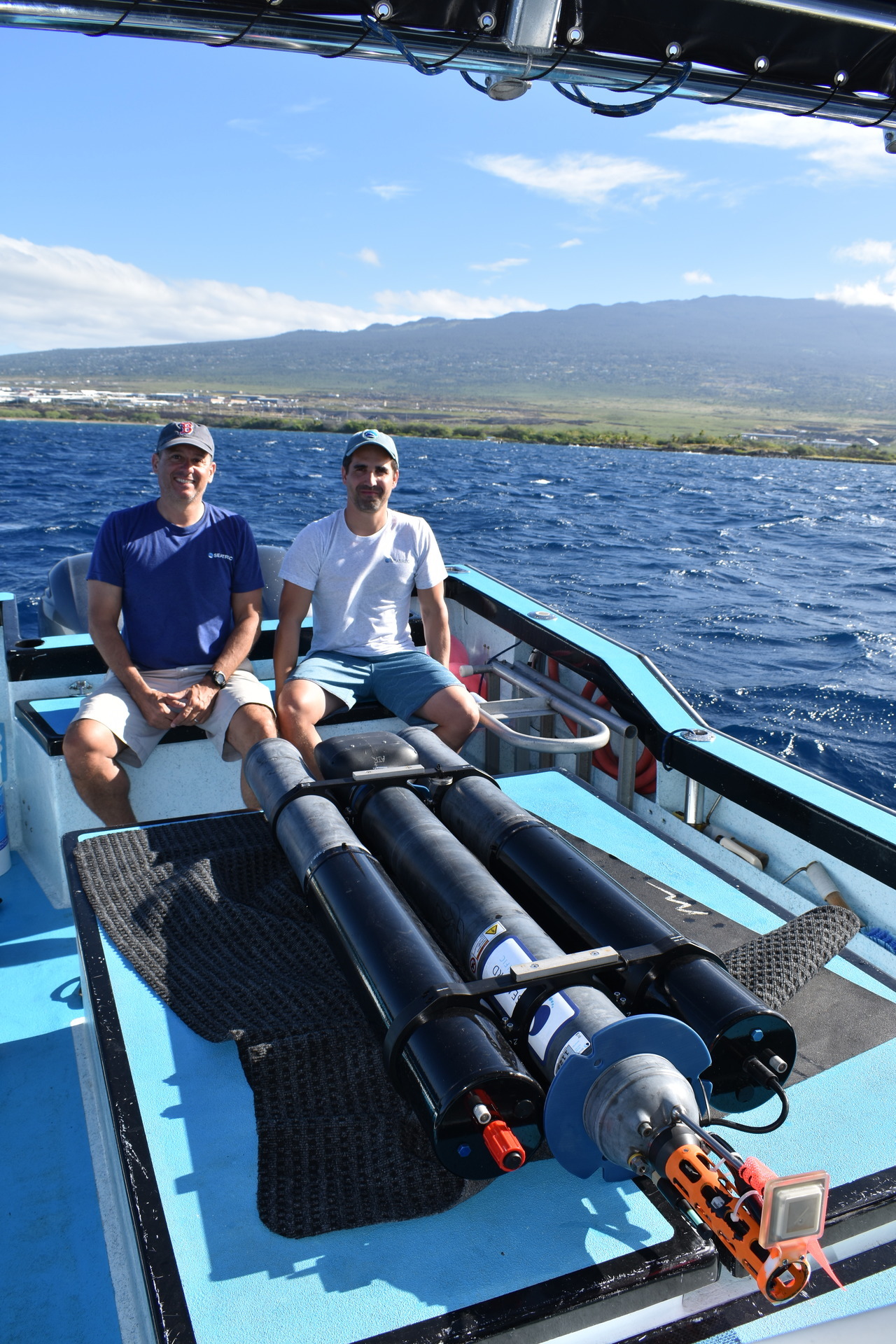Forbes Tech Council: Hurricanes Blow, But Our Forecasting Sucks
Our Founder and CEO, Yi Chao, is a member of the Forbes Technology Council. In his first contributed article, Yi addresses the challenges with hurricane forecasting.
2020 was an epic year for hurricanes with the most named storms on record. The rapid intensification of hurricanes, defined as a meteorological situation where a tropical cyclone intensifies dramatically in a short period of time, poses significant perils to coastal communities. Although hurricane forecasting has improved over the years, data problems abound with siloed data and a dearth of data below the ocean’s surface.
Read the article here.
Seatrec Raises $2M Seed Round to Commercialize Technology that Harvests Clean, Renewable Energy from the Ocean
Today, we're very excited to announce a $2M seed round to help us commercialize our energy harvesting technology that generates electricity from the temperature differences in the ocean. We are expanding our initial market of oceanographic research and defense to other Blue Economy areas such as aquaculture and maritime transportation.
Our funding round was led by previous investor Dr. Norge Larson with participation from Sunstone Management, Frontier Angels, SeaAhead’s Blue Angels, and returning investors from Pasadena Angels. Dr. Larson will bring his remarkable background in blue tech and business experience to Seatrec’s board as a director. Sunstone’s John Shen will join the board as an observer.
“We’ve proven the value of our clean, renewable energy harvesting technology with pilot sales to our beachhead market of research and defense,” said Dr. Yi Chao, founder and CEO of Seatrec. “Now, we’re ready to scale our commercial sales and expand the reach of our technology to power key applications in the Blue Economy like aquaculture and maritime transportation.”
Seatrec is the first company to produce a portable power system that harvests energy from naturally occurring temperature differentials. Its patented thermal energy harvesting technology provides infinite power and is currently used to run oceanographic equipment, including autonomous profiling floats and underwater gliders. With Seatrec’s technology, researchers can extend the life of the equipment, power more sensors, and enable faster data collection at reduced cost in an environmentally friendly manner.
Seatrec’s foothold in scientific research opens the door to collecting vast amounts of undersea data that can help increase the accuracy of forecasting hurricanes that are responsible for an estimated $54B in economic losses per year, as well as optimizing shipping routes to save millions of tons of fuel.
“Seatrec’s technology will power underwater robots to monitor the condition and health of the ocean,” explained Dr. Norge Larson, an oceanographer and entrepreneur. “This financing round helps Seatrec mature its products for several ocean applications. We are pleased to support this important work along with other key investors.”
The Blue Economy - sustainable, ocean-centric commerce - is expected to generate more than $3T in global economic impact and support more than 40M jobs around the world, according to the Organization for Economic Co-operation and Development (OECD). Aquaculture alone is projected to grow into a $274B per year market by 2025.
“Sunstone has a long history of identifying and investing in industry disruptors and cutting edge technology,” stated John Shen, founding partner of Sunstone Management and Seatrec's newest board member. “This innovative, sustainable technology is poised to rapidly revolutionize the Blue Economy with our enthusiastic support.”
Seatrec’s funding news comes on the heels of two recent $10,000 prizes under the Powering the Blue Economy: Ocean Observing Prize administered by the U.S. Department of Energy and NOAA. The company shared one of the prizes with Northrop Grumman for a joint Mission Unlimited UUV Station concept.
About Seatrec
Seatrec designs and manufactures energy harvesting systems that generate electricity from naturally occurring temperature differences in ocean waters. This renewable energy can be used to power deep water oceanographic research equipment such as floats, gliders and Autonomous Underwater Vehicles (AUVs), resulting in the most scalable, cost-effective deep ocean data collection possible. Incorporated in 2016 by CEO, Dr. Yi Chao, Seatrec’s technology originated at NASA Jet Propulsion Laboratory, California Institute of Technology, to provide clean power for remote off-grid locations. The company is headquartered in Monrovia, CA. Visit us at www.seatrec.com and @seatrecinc.
About Dr. Norge Larson
Dr. Norge Larson is a strategic advisor and previous investor to Seatrec. Dr. Larson was president of Sea-Bird Electronics until its acquisition by Danaher, one of the first successful exits for ocean tech companies. Larson joined Sea-Bird after obtaining his doctorate in oceanography from the University of Washington and helped establish the Sea-Bird Scientific as the gold standard for oceanographic sensors through the acquisition of Oregon ocean tech company Wet Labs and Canada’s Satlantic.
About Sunstone Management
Sunstone Management, with its subsidiary Sunstone Venture Capital Fund, is a diversified private capital management and investment firm offering comprehensive wealth management solutions to high net worth clients worldwide. Focusing on investments in U.S. based small businesses and lower-middle markets, its offerings are carefully structured to meet targeted investor goals ranging from short term senior debt products to longer-term, equity, growth capital, and venture capital investment strategies. For more information visit: sunstoneinvestment.com.
Here is the official press release.
Ocean Science Radio - Harnessing Energy from the Ocean
Seatrec - Thermal Energy Harvesting from the Ocean
In this episode of Ocean Science Radio, inquisitive aquanauts chat with our CEO, Dr. Yi Chao, and Senior Engineer, Michael Zedelmair, about Seatrec's thermal energy harvesting technology. Our team discusses how phase-change material helps harvest heat and pressure difference in the ocean to generate electricity for drones, research facilities, and possibly even small communities. Tune in to the whole interview with Andrew Kornblatt and Frances Farabaugh. (We also included highlights of the Q&A below.)
Definition of Energy Harvesting
Energy harvesting provides a method of powering electronics in areas where there are no conventional power sources. This includes remote or difficult-to-access locations, as well as underwater where batteries and traditional power deployment are not cost-efficient, practical, or sustainable to use. With energy harvesting, sources such as temperature gradients, light, mechanical load, vibrations, etc., are captured and converted to generate small levels of electricity.
Highlighted Q&A:
Challenges of Powering Ocean Drones and Robots Sustainably
Francis: On this program, we have covered a few different types of underwater vehicles and drones. From the incredible and dynamic mapping Sunfish to the anthropomorphic haptic sensor using Ocean One Robot. And that ever-growing international fleet of robots needs to find a way of charging their batteries.
Andrew: Rather than the lengthy process of pulling these robots back into their ship or boats and charging on land or by the boats’ diesel engine, imagine platforms that allow underwater drones to dock and charge on the go using locally and preferably sustainably generated energy.
Francis: Come with us now on an amazing journey to the world of Seatrec, who is doing just that.
Andrew: Welcome back to Ocean Science Radio, the podcast that brings you the latest, greatest, and sometimes deepest stories in the ocean. I am Andrew Kornblatt, ocean science, and conservation gunslinger.
Francis: And I'm shark researcher, aquanaut, and ocean nerd, Francis Farabaugh. When we think of energy harvested from the ocean, most think about tidal capture - pulling the energy from the motion of the ocean. But the engineers at Seatrec have found another way to pull energy from the ocean through the temperature differential of the different ocean layers.
Andrew: How does that work exactly? Well, first let's introduce former NASA scientist and CEO and Founder of Seatrec, Yi Chao.
From Caltech-NASA's Jet Propulsion Labs to Startup
Yi: My name is Yi Chao, Founder and CEO of Seatrec, a startup company based in Pasadena, California. We spun-off from Caltech NASA Jet Propulsion Labs a few years ago, commercializing the technology we developed at Caltech. Seatrec develops renewable energy technology - we harvest energy from the temperature difference in the ocean, so we can create this energy to power sensors and robotics underwater, which traditionally are powered by batteries with a limited lifetime. It is extremely difficult and costly to change batteries at sea, so we create energy in the ocean to power sensors directly.
Francis: As we mentioned, the actual method of harnessing energy from the ocean is a big game-changer here.
Yi: Any time you see a temperature difference, that is the energy you can harvest. So, if you think about the steam engine, you burn coal to create a 100°C temperature difference, and with that energy, you can generate electricity. Our innovation is to use a relatively small temperature difference - it’s about 10° Celsius or 18° Fahrenheit. We use a specific material that responds to the temperature by changing phases and expand the volume, so you basically when you warm up the material, you melt the material from solid to liquid, and then expand the volume to create pressure, and you can use that pressure to spin the motor, and that generates electricity.
Andrew: Many substances expand as they are heated and change phase from solid to liquid to gas. This expansion results in pressure that can be captured and used to generate electricity. Seatrec is developing techniques to generate energy from both the solid-to-liquid and the liquid-to-gas phase transition of several substances.
Phase-Change Materials and Thermodynamics
Francis: For more on the mechanics of how this all works, let’s introduce Michael.
Michael: Hi, my name is Michael Zedelmair; I’m a mechanical engineer at Seatrec. Since we’re a very small company, I am responsible for all mechanical engineering for everything we build. What we're doing is we build a unit that can be attached to any kind of ocean-going robot that dives in the ocean and therefore experiences different temperatures in the ocean. In most parts of the ocean, you have a warm surface, and the deeper you go, the colder the ocean gets. We’re using a material that's called phase-change material. In our case, it’s pentadecane, which, when it changes phase from a liquid to a solid, reduces its volume, and when it changes back to liquid, volume increases. We use that volume change to create pressure drives a hydraulic system that generates energy and stores it. The pressure differential results out of the volume change and the volume change happens during phase change and the reason why the material changes phase is that pretty much every material changes phase.
Andrew: Alright, Michael, hit me with an example.
Michael: The most simple example is water, which is actually the exact opposite because it changes - it actually expands when it freezes. Most other materials when they melt, they expand, which means when you pass a certain temperature, in our case 10°C, the solid turns into a liquid and expands, and that expansion, when contained in a pressure vessel, generates pressure. So whenever we have a prototype that we want to test in the ocean, we usually tend to go somewhere where it is pretty easy to get into deep waters. We could do all this off California's coast, but it would take quite a bit to get to deep enough water to do those tests. So we usually go to Kona, Hawaii, the Big Island, because it is essentially a volcano and the shore drops very quickly, and it gets very deep after probably 5 miles out, and that's where we deploy our units for testing.
Thermal Energy Harvesting in Kona, Hawaii
Francis: Not that anyone really needs an excuse to head to the lovely waters around Hawaii, but the easy access to an ocean dropoff wasn't the only reason that Seatrec chose Hawaii as a testing ground.
Michael: We performed those tests in Kona, because, first of all, it’s deep there. You have a warm surface water temperature, and as soon as you get to 400 meters roughly, you pass the 10-degree thermocline, which means we reach the point that we can actually generate energy roughly at 400 meters. And another advantage of Kona, or off the shore of Kona, is that there is sort of a raceway of currents, meaning that if you drop equipment in there and you're lucky enough, the equipment just does a little loop and comes back to you, so you can pick it up again. Actually, it went pretty good. We really had no major issue, and we got lucky with the weather, which can be pretty bad out there, I mean, anywhere in the ocean, but especially Hawaii since there is really just ocean all around. So, we had a couple of good days, some little choppy days, but overall it's been a good way to test our units.
Andrew: Michael keeps mentioning the units, so let’s describe what these things actually look like.
Francis: Think about a long plastic tube connected to a cable that transmits the energy produced. The full system is anchored to the seafloor, and the part known as the buoyancy engine module propels the unit up and down in the water column, harnessing the energy from the phase change of the substance therein.
Andrew: Think of those toys that used to come in cereal boxes, the plastic ones when you put them in a closed plastic bottle and squeeze, they would sink to the bottom. A similar image here, but this is taking the pressure and heat differences to generate electricity.
The Perils of the Sea
Francis: So these devices have been tested and proven in many places around the world, but not everything goes as swimmingly as their test in Hawaii.
Michael: There are certainly times when things don't happen the way you planned it, because you can do tests in a lab, and everything works the way you would expect it to work. But as soon as you're in the environment and then the ocean, things just happen differently than you would plan for.
We have had several occasions where things didn't work out the way we wanted to. For example, we had one deployment (not the one that we've just been at), where one of the units got in a current and then took off, and it actually drifted into the Maui channel, which is a channel between the Big Island and Maui. And it gets pretty rough there, and so we tried to go out there and find the unit. Imagine that everything you can see of the unit once you put it in the water is a little antenna. You're on a boat that's constantly moving, and all you got is a GPS signal that roughly tells you where the unit is, so you're looking into that direction you’re on a moving object and that little antenna that is bobbing up and down in the ocean with big waves. So in that particular situation, we were not able to get the unit, so we spent probably 5-6 hours on a rocking boat trying to not fall overboard and couldn't find anything. So we had to go back, try it again when the weather was not quite as bad. We actually waited until the unit drifted in through Maui channel into the waters that weren't quite as hostile, and then we were able to get it back, which meant we had to travel, I think, 70-80 miles offshore, which took us pretty much a whole day to get there and to get back.
Those are kind of the little things that can happen. So far, we've always been able to recover all of the prototypes that we're testing, which is pretty essential because all the data that we collect during a deployment is stored on the unit, so we kind of have to get it back to get any information about the sea trials. But sometimes it definitely happens that something just drifts away and you can’t get it back. So far, we've been lucky with that.
Surface vs. Subsurface (Going Deep with Energy Harvesting)
Andrew: So, what makes Seatrec’s technology unique?
Michael: There is a lot of technology that can extract energy from the ocean like waves or currents, or stuff like that, but the neat thing about the technology that we’re developing is that it works subsurface. If you go below the surface, you’re running out of opportunities pretty quick, because there's no wind, there's no solar, and that is actually where most of the, let's call it, robots - float, gliders whatever researchers use to better understand the ocean - that's where those units are most of the time. They're not at the surface. You don't really want to be at the surface because of rough weather or boats running into you. If you think about it this way, you want to generate energy somewhere, not at the surface in the ocean. That's kind of where we come into play.
Ocean Science Radio Commercial Break
Francis: So if you enjoy Ocean Science Radio, you should check out the growing library of podcasts we have at the Speak Up for Blue Network. You’ve probably heard Andrew and me on some other ones like Madame Curiosity or Dugongs and Seadragons.
Andrew: Let’s hear from one using an old-time radio filter. If you like Ocean Science Radio, why not tune into the marine conservation happy hour. It’s a little like a late-night talk show with alcohol and the latest marine science and conservation issues. Tune into the Marine Conservation Happy Hour twice a week every week. And now, back to our program.
Wanted: 10,000 Underwater Robots to Improve Weather Prediction
Francis: According to Dr. Chao, the future is filled with fleets of underwater robots. Seatrec is at the head of a growing market.
Yi: Well, today, there are about a few thousand of the robots in the ocean at a given time. According to the vision of oceanographers 20 years ago, we need at least ten times more robots than we have today. Our vision is that with our technology, it is economically feasible and sustainable to the environment to have tens of thousands of robots in the ocean, so we can collect those missing data sets for weather prediction to climate forecasting. We can potentially provide continuous power for those devices to help communication, signal relay to power weather stations in the Arctic, and I’m also reaching out to remote villages in Alaska and Canada. We can potentially help them generate local microgrids and provide electricity for homes and local communities, where it is difficult to use solar power, wind power, or they have logistical challenges to deliver diesel. There are a number of directions we’re exploring in the future - we’re not selling in these areas right now, but we are doing R&D to expand our technology into those spaces.
Francis: According to Dr. Chao, the applications for this technology, since it is scalable, can really make a whale of a splash, which is why Seatrec has already won two $10,000 prizes under the Powering the Blue Economy Ocean Observing Prize administered by the US Department of Energy and NOAA.
Andrew: They also got initial seed investing from Breakout Labs and Schmidt Marine Technology Partners. So how did a NASA scientist specializing in satellites get to ocean work?
Monitoring Ocean Health without the Power Bottleneck
Yi: That’s an interesting journey. I was trained as an oceanographer studying ocean sciences and got my Ph.D. from Princeton. My first job was working at NASA Jet Propulsion Labs to develop satellites to study the ocean from space/. After 20 years, I ran into this major obstacle.
Andrew: Dr. Chao’s work has led him to take a long hard look at the problems facing the collection of ocean data and possibly money-making solutions to those problems.
Yi: It can be physical parameters of the ocean, chemistry, or biological parameters. They can be used by oceanographers to study climate change, improve hurricane prediction and weather prediction. We are designing our energy system for these kinds of vertical diving robots. In the last couple of years, we have been commercializing the technology and the goal of this year’s deployment is to a thousand-meter diving capacity of an energy system.
Francis: Dr. Chao realized that as amazing as satellite technology is at monitoring sea surface, you couldn’t really get the best imagery and data below the sea surface. We still need to measure how things are working and changing deeper down in the water column.
Yi: Our technology is a way to monitor these changes. One of the biggest challenges is how do you take the pulse of the ocean? How do you go to the sea and then measure how the ocean changes from the surface to 1000 meters down. That's really a fingerprint of climate change. You don't know how the ocean will respond; you cannot have a reliable computer model to predict future climate change.
In the last decade or so, we have been making major breakthroughs in robotic technology to monitor the ocean conditions, and our technology is taking that step further to scale-up the number of the robots and then the capability of the robots to attach more and more powerful sensors to monitor not only the temperature change and how the chemistry, the biology respond to the climate change as well, so we can address ocean health, ecosystem change, and fisheries, and the other important aspects important to human life.
Andrew: One of the secret issues with ocean exploration and sciences is that while most try to be as sustainable and cost-saving as possible and collect every piece of technology deployed, sometimes, once an underwater vehicle finishes its mission and dies, there isn't funding, time, or the ability to collect it.
Like Throwing Out Your Tesla When Your Battery Runs Out
Yi: Today, we use more and more powerful lithium batteries, but they have their limitations as well. They have a limited lifetime. When the battery dies, you'll have to hire a ship or throw the battery into the sea, so neither is not economical or environmentally not scalable. So in the last 10 years, I have been developing this technology trying to address this challenge to provide renewable energy to power those robots in the deep ocean.
Francis: These super expensive robotic gliders and floating sensor stations monitoring the world's oceans are sometimes effectively treated as disposable devices, and are therefore sometimes a waste of money, not to mention they're also contributing to a growing assortment of abandoned lithium-ion batteries. These could be polluting the ocean through leaking toxic materials. Dr. Chao hopes that his technology and what his team is working on can help solve this issue.
Yi: The current practice here is currently not sustainable. Imagine you’re driving a Tesla, and every time you run out of battery, you throw your Tesla away and then buy a new one. You put a Tesla on the roadside; that's essentially what we are doing for ocean robotics. We have a number of R&D projects to expand this technology into other spaces. For example, we are designing a power station in the Arctic ice for the Navy right now. So the Arctic sensor exploration may pretty much rely on diesel generators and deliver diesel with an Icebreaker. As you can imagine, this is expensive, and it is difficult to survive in the winter. So our goal is to harvest energy in the Arctic from the air-sea temperature difference. So there's very cold in the air, relatively warm in the water, so we potentially can provide continuous power for those devices.
Data, Data, Data - Making a Positive Impact on Our Blue Planet
Andrew: If you ask Michael and Dr. Chao, what is driving them in their work, what really inspires them is a sense of discovery, innovation, and positive impact.
Michael: if we think about the things we know about our planet and we look on land, and we know a lot, I mean you can get anyplace fairly easily, but if you think about our oceans, there's a saying that, “We know more about the surface of the moon than we know about our oceans.” It’s actually on the same planet, and that's kind of crazy, so I'm super excited that we’re developing something that makes it possible in the future to just collect more data to help us understand what the impact is on the ocean on our everyday life on the planet and the whole fisheries. I think I'm pretty lucky to be able to work on something that really has a meaning, and that can make a difference.
Yi: The message I want to convey to your audience is the ocean is mysterious, we know very little about the ocean, we only explore a small fraction - less than 10% of the ocean, and there's a lot of information we can collect in the ocean through this technology enabled by our technology. We can provide that information at the fingertips of decision-makers and policymakers, and also for researchers, industries to make better decisions to support aquaculture, for example, providing future seafood to the human society and also protect our ocean at the same time.
Francis: One thing to remember is that this technology is scalable, and the work of Seatrec continues. If you have a project that you need an energy solution, and this podcast makes you go, “Hmmm,” you should reach out.
Andrew: I mean, I just want one. Maybe put together a floating platform with a couple of those Sunfish drones we were talking about?
Francis: Maybe you can power an underwater research laboratory?
Andrew: They do talk a little bit about powering buildings and powering small villages, and if they can power that much, they can definitely power things like the Aquarius Reef Base.
Ocean Science Radio Summary
Francis: A big thanks to our guests who joined us and big thanks to you, our listeners.
Andrew: Be sure to like, rate, subscribe, and share this podcast with your friends and family. Until next time this has been another Ocean Science Radio.
Ocean Science Radio is a joint project between Andrew Kornblatt, founder and host of the Online Ocean Symposium, and Naomi Frances Farabaugh of FIU.
Seatrec, Northrop Grumman Receive DARPA Award for Developing Deep Sea Robots to Study Climate Change and Support Blue Economy
Seatrec, Northrop Grumman Receive DARPA Award for Developing Deep Sea Robots That Can Study Climate Change and Support Blue Economy
Small Business Innovation Research Phase II is next step toward commercialization of fast-diving, autonomous robots that are powered by Aluminum fuel
Seatrec, a renewable energy company that harvests energy from temperature differences in the environment, announced today that it has been awarded a Phase II Small Business Innovation Research (SBIR) grant from the Defense Advanced Research Projects Agency (DARPA). As part of the grant, Seatrec has assembled a multi-disciplinary team of scientists and engineers and subcontracted Northrop Grumman to support the development of a float that can dive to 1000 meters at a speed of 1 meter per second, a factor of 10 faster than the current state-of-the-art.
Dr. Yi Chao, Founder and CEO of Seatrec, is the Principal Investigator on the grant and built the company’s technology he started at NASA’s Jet Propulsion Laboratory.
“Today’s buoyancy engines are too small to support such a fast profiling speed. If we increase the size of the buoyancy engine and add a propeller, the required 1 m/s speed can be achieved, however, a significantly larger battery would be necessary in order to maintain long endurance. We’re excited to partner with Professor Doug Hart from MIT to explore the use of aluminum fuel, when mixed with water, to create the extra buoyancy required to achieve a 10x increase of the profiling speed,” said Chao.
“Aluminum, long used as a solid rocket propellant, is among the most energy-dense materials known but has found little use in other applications due to difficulties in harnessing its power. My group at MIT has developed a method to safely create a liquid slurry that can be reacted with water on contact releasing hydrogen gas and heat. In this project, the hydrogen gas will be used to generate positive buoyancy to achieve an order of magnitude increase in profiling speed,” said Hart.
“Ocean data needs a sea change to help navigate the warming world,” stated in a recent article in Nature, “The ocean covers about 70 percent of Earth’s surface, regulates the climate and it’s home to countless species of fish, a major source of protein for more than one billion people. It is now under threat from climate change, overfishing and pollution.” This technological advancement will certainly accelerate the evolution of ocean observation and monitoring.
“There are simply no other energy harvesting solutions available like Seatrec. The synergy of these innovative technologies and our experience in developing military-grade solutions will result in a very promising offering to better observe our oceans,” said Brian Theobald, Chief Engineer for Northrop Grumman Undersea Systems.
About Seatrec
Seatrec designs and manufactures energy harvesting systems that generate electricity from naturally occurring temperature differences in ocean waters. This renewable energy can be used to power deep water oceanographic research equipment such as floats, gliders, and Autonomous Underwater Vehicles (AUVs), resulting in the most scalable, cost-effective deep ocean data collection possible. Incorporated in 2016 by CEO, Dr. Yi Chao, Seatrec’s technology originated at NASA Jet Propulsion Laboratory, California Institute of Technology, to provide clean power for remote off-grid locations. The company is headquartered in Monrovia, CA. Visit us at www.seatrec.com and @seatrecinc.
Media contact
Marta Bulaich
Head of Marketing
marta@seatrec.com
+1 415-816-1665
These Underwater Drones Use Water Temperature Differences To Recharge
Recharging Ocean Drones with Renewable Energy
Check out the interview with our CEO and Founder, Dr. Yi Chao, with Jeremy Hsu in IEEE Spectrum. In the interview, Yi talks about how Seatrec uses thermal energy harvesting to recharge ocean floats and gliders with renewable energy generated by ocean temperature differences. A summary is below. Click here for the full article.
Thermal Energy Harvesting
Today, most floats are treated as disposable devices due to power and financial challenges. Power challenges arise because the lithium-ion battery energy is limited. Once the battery dies, the float and accompanying potentially toxic battery drop to the bottom of the ocean. Financial limitations are in play because oceanographers lack the funding to deploy ships to retrieve these derelict floats. Yi's goal is to leverage Seatrec's thermal energy harvesting systems to eliminate toxic battery disposal. Additionally, with our technology, we can improve the durability of ocean drones and improve the data collection and frequency of profiling.
Underwater Charging Station for UUVs
Seatrec is collaborating with defense giant Northrop Grumman to develop an underwater recharging station for ocean robots. Northrop has created a self-insulating electrical connector capable of operating while the powered electrical contacts are submerged. Seatrec and Northrop won a $10,000 prize under the Powering the Blue Economy: Ocean Observing Prize administered by the U.S. Department of Energy and NOAA to develop this technology.
Yi is most excited about collecting as much oceanographic data as possible and exploring other blue economy ventures such as aquaculture (underwater farms) and other subsurface applications.
Northrop Grumman And Seatrec Recognized For Self-Sustaining UUV Charging Station
Northrop Grumman and Seatrec, Inc. were recently winners of an Explorer Prize, which concluded the Discovery competition phase of the Powering the Blue Economy™ Ocean Observing Prize, sponsored by the Department of Energy (DOE) and the National Oceanic & Atmospheric Administration (NOAA).
Read more on Northrop Grumman's news site.
Teaming Up for Right Whales Using Gliders
Ocean gliders are able to detect multiple marine animals such as whales in near real-time. These gliders can be instrumental in preventing lethal ship strikes as endangered whales migrate through shipping lanes and fishing grounds. For example, when a glider detects a whale (or any species of interest), it can send a text message to scientists, regulators, and ships in the vicinity.
And, we're proud to note the cool shout out to our very own Dave Fratantoni. About 10 years ago, Dave worked on a digital acoustic monitoring device (#DMON), while working with WHOI scientists and engineers Mark Johnson, Jim Partan, et al.
Cleantech Companies Ride the Sustainable Investing Wave in LA
LA's cleantech startup scene is making waves, and we're in stellar company with Lauren Gropper from Repurpose and funding from prescient SoCal investors like LACI and Pasadena Angels. Thanks, James B. Cutchin, for featuring our sustainability community and the greener (and bluer) world we're aiming to build.

